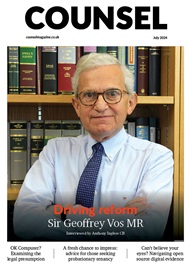*/
Almost two-thirds of the lawyers recruited to become judges last year went to state schools, according to the latest figures from the Judicial Appointments Commission (JAC).
The data was based on 28 selection exercises conducted in the year ending March 2018, for which 5,125 lawyers applied and 729 were recommended for appointment.
In the legal competitions, 63% of those recommended for immediate appointment were educated at a state school, compared to 35% who went to fee-paying schools, with 2% educated abroad. In addition, 59% were the first in their family to have attended university.
Overall, 40% of those recommended for immediate appointment were women, only 9% came from a black or ethnic minority background and 7% said that they had a disability.
Barristers still accounted for most applications and appointments – solicitors made up 36% of applicants and 21% of those recommended, while barristers represented 50% of applicants and 59% of those recommended.
When it came to appointments to the High Court, 52% had attended a state school and 47% had been educated privately, 27% were female and 5% were from an ethic minority background.
The JAC statistics suggest that the judiciary, which has traditionally been dominated by white men who attended private schools, may slowly be becoming more diverse, although more than 70% of senior judges are from private schools.
Almost two-thirds of the lawyers recruited to become judges last year went to state schools, according to the latest figures from the Judicial Appointments Commission (JAC).
The data was based on 28 selection exercises conducted in the year ending March 2018, for which 5,125 lawyers applied and 729 were recommended for appointment.
In the legal competitions, 63% of those recommended for immediate appointment were educated at a state school, compared to 35% who went to fee-paying schools, with 2% educated abroad. In addition, 59% were the first in their family to have attended university.
Overall, 40% of those recommended for immediate appointment were women, only 9% came from a black or ethnic minority background and 7% said that they had a disability.
Barristers still accounted for most applications and appointments – solicitors made up 36% of applicants and 21% of those recommended, while barristers represented 50% of applicants and 59% of those recommended.
When it came to appointments to the High Court, 52% had attended a state school and 47% had been educated privately, 27% were female and 5% were from an ethic minority background.
The JAC statistics suggest that the judiciary, which has traditionally been dominated by white men who attended private schools, may slowly be becoming more diverse, although more than 70% of senior judges are from private schools.


The Chair of the Bar sets out how the new government can restore the justice system
In the first of a new series, Louise Crush of Westgate Wealth considers the fundamental need for financial protection
Unlocking your aged debt to fund your tax in one easy step. By Philip N Bristow
Possibly, but many barristers are glad he did…
Mental health charity Mind BWW has received a £500 donation from drug, alcohol and DNA testing laboratory, AlphaBiolabs as part of its Giving Back campaign
The Institute of Neurotechnology & Law is thrilled to announce its inaugural essay competition
How to navigate open source evidence in an era of deepfakes. By Professor Yvonne McDermott Rees and Professor Alexa Koenig
Brie Stevens-Hoare KC and Lyndsey de Mestre KC take a look at the difficulties women encounter during the menopause, and offer some practical tips for individuals and chambers to make things easier
Sir Geoffrey Vos, Master of the Rolls and Head of Civil Justice since January 2021, is well known for his passion for access to justice and all things digital. Perhaps less widely known is the driven personality and wanderlust that lies behind this, as Anthony Inglese CB discovers
The Chair of the Bar sets out how the new government can restore the justice system
No-one should have to live in sub-standard accommodation, says Antony Hodari Solicitors. We are tackling the problem of bad housing with a two-pronged approach and act on behalf of tenants in both the civil and criminal courts